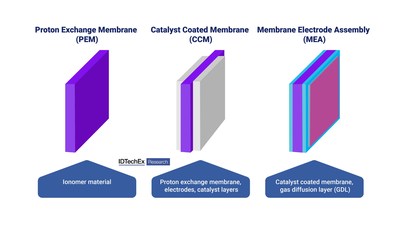BOSTON, Dec. 7, 2022 /PRNewswire/ -- Catalysts are
critical for the performance of proton exchange membrane (PEM) fuel
cells. As the trend towards zero-emission vehicles continues, fuel
cell electric vehicles (FCEVs) are projected to grow accordingly as
a market sector. The annual demand for typical catalytic materials,
such as platinum group metals, is set to exceed 3.5 metric tonnes
by 2033. In this article, IDTechEx presents an overview of the
catalytic materials market and assesses the key trends for this
sector over the coming decade.

IDTechEx covers the electric vehicle industry comprehensively,
detailing battery electric vehicles (BEVs) and FCEVs. The FCEV
research is segmented by passenger cars, light commercial vehicles
(vans), heavy-duty trucks, and city buses. They have released a new
report, "Materials for PEM Fuel Cells 2023-2033", which includes
granular 10-year forecasts segmented by vehicle type for key fuel
cell components and materials in terms of both units and volume,
while also detailing the value associated with each
segmentation.
Catalysts are necessary for PEM fuel cells to enable the
chemical reaction to occur effectively at sub-100°C temperatures,
allowing the aqueous conditions that the PEM requires for proton
transport. Typically, platinum and other platinum group metals
(PGMs) are utilized as catalysts; however, the high cost of these
precious metals is inhibitive to the cost reduction of the overall
fuel cell stack.
When discussing catalysts for PEM fuel cells, it is imperative
to define the area of interest succinctly. While 'catalyst' is an
all-encompassing term, IDTechEx notes that catalyst-coated
membranes (CCM) cannot be discounted from the conversation. CCMs
account for the membrane material with an integrated catalytic
layer. This CCM is often sandwiched between gas diffusion layers
(GDL) to create a fully integrated component known as a membrane
electrode assembly (MEA). For the purpose of this article, IDTechEx
will cover the trends seen for the catalytic material itself.
Primarily, there is a drive to reduce the fuel cell stack cost.
Given the high value of PGMs, increasing the catalytic activity of
the metals would reduce the volume of precious metal required. This
can be done by exploring alternative metals such as the
Pt3Ni alloy or gold nanoparticles. Another option is to
change the form factor of the Pt catalyst, optimizing the number of
active catalytic sites. The IDTechEx report covers all of these
developments in detail, alongside a review of the targets set by
government bodies and an assessment of the current and future
loading employed by major players in the value chain.
The reduction of catalytic poisoning in the fuel cell would
allow the less precious metal to be used in the stack. Poisoning
occurs when carbon monoxide permanently bonds to the platinum
catalyst, decreasing desirable catalytic activity. Carbon monoxide
(CO) is an unwanted hydrogen gas component produced by
steam-reforming hydrocarbons. It should be noted that mass
production of pure hydrogen via electrolysis can negate the issue
of CO contamination. Other attempts to limit catalytic poisoning
involve altering the shape of the catalyst nanoparticles, with
certain molecular arrangements of the catalyst providing sites that
are less likely to be contaminated by CO bonding.
A major aspect of reducing the catalyst cost is finding
alternative materials to the incumbent precious metal – platinum.
Some of these materials have already been mentioned, such as the
Pt3Ni alloy and Au nanoparticles. Metal/nitrogen/carbon
(MNC) catalysts have been proposed as promising alternatives.
Although volumetric catalytic activity is only 10% of that seen for
Pt, increased loading of MNC catalysts has been proposed as a
solution to mitigate this concern due to lower costs. Leading
providers of catalyst for fuel cells offer a range of materials,
from Pt to IrO2. The report from IDTechEx details the
key suppliers of PGM catalysts to OEMs and forecasts the demand for
PGM materials and the value associated with integrating these
metals into a CCM.
For more details on the materials demand, trends, and emerging
novel alternatives to the incumbents for PEM fuel cells, please see
the IDTechEx market report "Materials for PEM Fuel Cells
2023-2033".
About IDTechEx
IDTechEx guides your strategic business decisions through its
Research, Subscription and Consultancy products, helping you profit
from emerging technologies. For more information, contact
research@IDTechEx.com or visit www.IDTechEx.com.
Images
Download:
https://www.dropbox.com/scl/fo/1lacalbuyowdjmnv6hpk3/h?dl=0&rlkey=ipcm6da9t9t8z0cliklj6hskp
Media Contact:
Lucy Rogers
Sales and Marketing Administrator
press@IDTechEx.com
+44(0)1223 812300
Social Media Links:
Twitter: www.twitter.com/IDTechEx
LinkedIn: www.linkedin.com/company/IDTechEx
Facebook: www.facebook.com/IDTechExResearch
Photo:
https://mma.prnewswire.com/media/1963569/IDTechEx_PEM.jpg
Logo: https://mma.prnewswire.com/media/478371/IDTechEx_Logo.jpg
 View original
content:https://www.prnewswire.co.uk/news-releases/catalysts-for-change-the-key-trends-for-pem-fuel-cell-catalysts-reports-idtechex-301697098.html
View original
content:https://www.prnewswire.co.uk/news-releases/catalysts-for-change-the-key-trends-for-pem-fuel-cell-catalysts-reports-idtechex-301697098.html